History
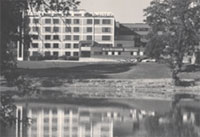
Riverside Medical Center, 2004
Over 55 Years of Commitment to the Community
Dear Friends of Riverside Medical Center:
In many ways, the world is very different today than in 1964 when Riverside Hospital opened in response to a need for another facility within a growing community. Technology has advanced by light years, laws regulating healthcare have changed dramatically, and today’s updated facility bears little resemblance to the original structure.
What has endured throughout Riverside’s more than 55 years is our commitment to delivering excellent service to promote health and lead the way in providing this community with a superior, comprehensive healthcare system that operates in a caring, highly-efficient and competitive manner. Now and in the future, Riverside Healthcare maintains excellence through the efforts of a talented team of dedicated professionals and support staff whose actions exemplify excellence. You and your family can count on us to uphold our mission of providing quality, caring service that improves the health status of the communities that we serve.
Neighbors Caring for Neighbors
The history of Riverside HealthCare drapes across the years like a tapestry, rich with the vibrant colors and inescapable warmth of the many people who have contributed to its success over 50 years.
The threads of the tapestry have been woven in by individuals too numerous to name in these few pages. It starts with the original founders and contributors, neighbors caring enough about their neighbors to act on their dreams and convictions. The tapestry embraces every physician, nurse, technician, support staff member and volunteer who has helped a patient, directly or indirectly, over the years. It also encircles all who have given the cloth its strength by serving on the Hospital Board of Directors, Riverside Medical Center Foundation and Riverside Auxiliary over the years.
What binds the tapestry together is a mission of delivering healthcare services on a regional basis that are focused on improving the health status of the communities that we serve in a meaningful and caring manner. Riverside Medical Center stands today as an organization much more complex than the one opened in 1964, yet steadfast in its commitment to excellence.
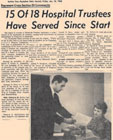
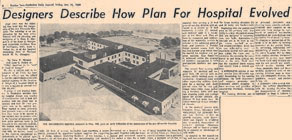
The Tapestry Begins
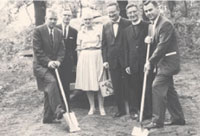
The first fibers of tapestry came together in 1956. At that time, Dwight D. Eisenhower was President of the U.S., the first open-heart surgery had been successfully performed in Philadelphia only a few years earlier and, in the wake of a polio epidemic, a new vaccine was being administered to youngsters across the nation.
Close to home, the only area hospital was overcrowded and inadequate to serve the growing need of the region for quality healthcare. It was evident that the rapidly growing population in Kankakee and its surrounding communities needed another hospital. Fortunately, a group of determined individuals persevered in their concerns.
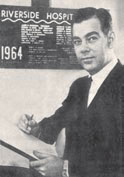
Chief Executive Officer
In December 1958, a Chamber of Commerce subcommittee, chaired by James G. Schneider recommended that a private non-profit foundation known as the Stewards Foundation be invited to build a 150-bed hospital in Kankakee. After unfilled promises and delays, the committee severed ties with the Stewards Foundation to build a 136-bed hospital funded by the community with aid from federal grants. The Hospital Committee continued under the leadership of James Schneider and it purchased seven acres of scenic land at Riverside’s present site from Burrell and Len Small who donated an additional three acres.
After appealing to the community to submit name suggestions for the new facility, Kankakee County Hospital became Riverside Hospital in 1961. Construction began in May 1962 and Robert G.Miller was named Chief Executive Officer in January 1963.
Even before Riverside Hospital opened its doors, it was accepted into the Illinois Hospital Association and American Hospital Association. And in 1961, before the groundbreaking, 20 people attended the first organizational meeting of the Hospital Auxiliary. Mrs. Edgar Shipley served as first Auxiliary President and the organization boasted 575 auxilians by the time the hospital opened.
The 136-bed Riverside Hospital was dedicated January 12, 1964. An open house on January 11 drew 3,000 visitors, despite a Chicago-style blizzard. The doors officially opened on January 22 with 125 employees and 69 physicians. Within a month, there were 186 full-time employees and 40 working part-time.
Riverside Expands Quickly
Private Room $30/day
Semi-private $24/day
4-bed ward $19.50/day
The United States ventured into outer space during the tenure of John F. Kennedy and Riverside had plans for expansion underway before its first anniversary. A specific plan facilitated organized growth, enabling patient services to go upward while ancillary services expanded outward.
In May 1965, Riverside purchased another 8.8 acres from the Small Family, and by year’s end, construction began on a three-story addition that not only expanded the Labor and Delivery area but also tripled the laundry capacity and doubled the X-ray department. With a newer, larger front entrance and lobby, the hospital also added 74 beds for a total of 210.
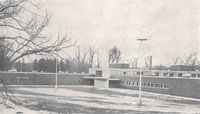
While growing its physical size, Riverside also led the way in excellence for patient care. In 1966, the hospital received its first accreditation from the Joint Commission on the Accreditation of Hospitals (since renamed the Joint Commission), a mark of excellence it has always maintained. A new eight-bed Intensive Care Unit opened with electronic patient monitoring and the Board approved a recommendation to develop a 30-bed Psychiatric Unit. A new Pediatric Unit, designed exclusively for children, opened in 1968.
During the late 1960s, Riverside Hospital collaborated with Olivet Nazarene University to provide the clinical training for a four-year nursing degree program and with Kankakee Community College to establish a two-year Associate Degree Nursing Program. Riverside Foundation was established in 1967 with Vernon Butz as President “to generate philanthropic support to enhance the availability and quality of the healthcare services provided by” the hospital. Since then, the Foundation has been supported by generous and thoughtful individuals, companies, and organizations that have given annual gifts, bequests, insurance, real estate, stocks and cash donations.
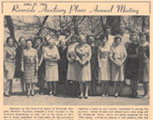
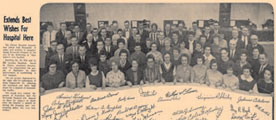
The Tapestry Evolves
While students wearing bell-bottoms and love beads promoted revolution in the 1970s, the emphasis at Riverside was evolution – developing facilities and services.
In 1971,William Brandenburg donated 65 acres of farmland on the south side of the river, adjacent to Kankakee Airport, designated for the Riverside Foundation.
In 1970, Riverside started construction of a $1 million addition, the first phase of a master plan. It was completed in 1971 with the opening of a new surgery suite and central sterile supply area and relocation of the Emergency Room. A year later, phase II of the plan brought a new coronary care unit to a now completed fifth floor as well as more room for diagnostic and ancillary services: new clinical lab, radiology suite, medical records, medical library, physical therapy unit and an enlarged maintenance and engineering plant.
Construction didn’t stop there. In 1974, a continuing education area was completed on the lower level and the OB delivery-maternity wing was remodeled. And in 1976, a new development plan called for building a new mental health unit, day surgery facilities and a new intensive care unit. Remodeling began on respiratory care, dietary, materials management and cardiac testing areas. The intensive care unit opened in 1978, along with a new outpatient clinic.
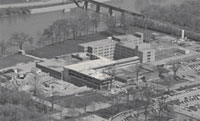
During this time frame, Riverside received approval for a 50-bed Mental Health Unit and began its Psychiatric Day Hospital Program. Since 1972, Riverside’s Behavioral Health Services has been improving and ensuring the mental health and well being of children and adults an extensive complement of care. Programs include inpatient and outpatient, short-term and long-term counseling, alcohol and chemical dependency treatment, crisis intervention and aftercare to help prepare patients for their return into the community after hospitalization. Today, Behavioral Health offers programs in many locations in the communities of Kankakee,Will, Grundy, Livingston, Iroquois and Southern Cook Counties.
Riverside and the Kankakee Rotary participated in the Meals on Wheels program providing 125 meals a day to area residents who needed temporary or long-term assistance to live independently. The Rotary provided the containers while churches and auxilians provided volunteers to deliver the meals.
On Riverside’s 15th anniversary in 1979, the hospital was renamed Riverside Medical Center to reflect Riverside’s growth from an inpatient facility to a comprehensive, multiple-service health organization for the community with 315 beds and 1,000 employees.

The Tapestry Unfurls Even Further
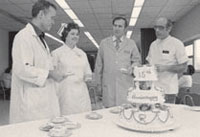
As the 1980s dawned, some of us stood in line to see the movie Flashdance while others mourned TVs last episode of Mash. At Riverside Medical Center, commitment to steady growth continued.
Riverside opened its first community center – Pembroke Community Health Center in Hopkins Park – with a focus on patient satisfaction in 1981. Additional Community Health Centers followed soon after in Momence. Today there are 15 freestanding centers, making primary care physicians, specialists and services including lab, physical therapy and X-ray, readily available close to home for more area residents.
The Medical Center adopted a new Mission Statement in the 1980s:
Riverside Medical Center and its medical staff exist to promote health and provide the community with a superior, comprehensive healthcare system that operates in a caring, highly efficient and competitive manner. Our healthcare system shall maintain excellence through the efforts of a talented team of dedicated professionals whose actions exemplify a “Caring at its best” attitude. Riverside is committed to serving as a Medical Leader …a center of caring.
In line with its new mission, Riverside invested in additional cutting-edge technology to analyze pediatric blood chemistry and toxicology. Investments were also made in radiographic equipment including the full body CT scanners and the linear accelerators.
Riverside also implemented its Home Health Care service, quickly receiving Medicare licensure, and established the Riverside Health Equipment Store to supply area residents everything they need for comfortable and safe home care. Today the store is the largest service of its kind in the Region, offering extensive home health products, wheelchairs and lifts, respiratory care items, all with the kind of customer service only local owners can deliver for sale, rental and service.
Riverside’s Emergency Department was designated a Level II Trauma Center by the Illinois Department of Public Health in 1988. This designation guarantees the immediate availability of specialized surgeons, anesthesiologists, trauma nurse specialists and emergency medicine physicians with advanced trauma training 24 hours a day. The Emergency Department also holds EDAP (Emergency Department Approved for Pediatrics) designation. That means it has the skilled staff and age-appropriate equipment to treat children of all ages.
The Riverside Senior Living Center Corporation was established in 1989 and a 10-acre parcel was approved for development of an independent living center for senior adults.
In 1988, Riverside set up its Sleep Laboratory. Sleep studies and services, previously provided only at university medical centers, were now available in the Kankakee community. Sleep studies identify the cause of a patient’s sleep disorder and help specialists determine the most effective means of treatment.
This era culminated in Riverside’s 25th anniversary and a rededication in 1989.
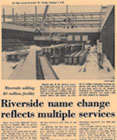

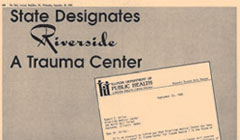
Riverside Weaves New Dreams
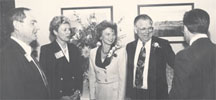
While the old Millennium was winding down, Riverside took a running leap, not just into a new Century but a new Millennium. During the 1990s, plans unfolded for new services for seniors and more advanced care for those with cancer, heart disease and other problems. Under the leadership of Board Chairman, Connie Ashline, the hospital entered the 1990s. One of her first responsibilities was to facilitate the transfer from retiring long-time CEO Robert G.Miller to a new CEO. The search committee selected Dennis C.Millirons, who assumed the responsibilities of President and CEO of all Riverside affiliates on January 1, 1994.
Recognizing the need for a relationship with a Chicago-based healthcare delivery system, Riverside began the process of evaluating its options. In 1996, the affiliation with Rush-Presbyterian-St. Luke’s Medical Center (now Rush University Medical Center) became a reality. Through strong strategic and clinical ties, the Rush-Riverside relationship has produced lasting value for the people of the Kankakee Region.
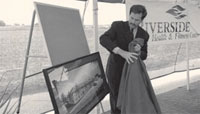
Living options for seniors opened up with the construction of 90 senior independent living apartments at Westwood Oaks, 48 senior assisted living apartments at Butterfield Court and the opening of Miller Center, a 120-bed skilled nursing facility.
Riverside purchased the former Alco Discount Store in Bradley as a satellite location to house health equipment, ambulance, wellness services, outpatient rehabilitation and occupational health services, naming it “Riverside Atrium.”
It now serves as a medical mall with offices for physicians, a single-specialty orthopedic surgery center, an occupational medicine clinic, physical rehabilitation facilities and the ambulance headquarters for Riverside Ambulance.
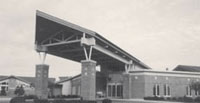
To make the benefits of health and wellness available to more area residents, Riverside built a state-of-the-art Health Fitness Center in 1997, with training equipment, an indoor track, swimming and exercise pools, climbing wall and much more. As a hospital-based center, the staff is especially sensitive to the needs of those who are not in the best of health. The facilities are easily accessible for people with wheelchairs or walkers and there are programs geared toward those with chronic problems, such as arthritis, fibromyalgia, heart disease or back pain. The 70,000 sq. ft. facility in Bourbonnais includes child care, professional fitness consultations, whirlpool, massage and numerous other amenities. Riverside Health Fitness Center also houses certain outpatient services for convenience, including sports medicine and rehabilitative medicine.
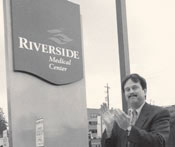
Riverside and Olivet Nazarene University formed a partnership with Olivet’s Athletic Department to develop a training program for Athletic Trainees supported by Olivet Nazarene University and Orthopedic Associates of Kankakee. The Community Alliance (comprised of Riverside, Olivet Nazarene University, Kankakee Community College and Provena St.Mary’s Hospital) formed to provide seed money for the development of the Family Violence Council. In addition, they purchased automatic external defibrillators to be placed in local and county police cars.
In 1999, the Riverside Heart Center became a reality. A defining decision regarding Riverside’s future was to pursue the development of open-heart surgery. After five years of preparation and planning by Riverside leadership, the Illinois Health Facilities Planning Board approved Riverside Medical Center’s request to do open-heart surgery in early 1999. The first procedure was performed in October 1999 and today, the program continues to grow with over 2,500 procedures annually in the Heart Catheterization Laboratory, and over 250 open-heart surgeries each year. The Riverside HealthCare Foundation committed $1 million toward the expense of the program start-up.
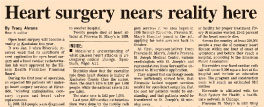

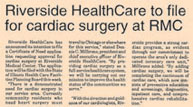
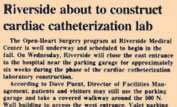
Disaster Tests Emergency Responsiveness
The memory is still vivid for many in this community. On March 15, 1999, at a railroad crossing in Bourbonnais, Amtrak’s City of New Orleans passenger train from Chicago collided with a truck transporting 22 tons of steel. The crash derailed 11 of the train’s 14 cars, plus two locomotives, One locomotive split, leaking diesel fuel that ignited the front three cars. Within minutes, 35 ambulances and scores of police and firefighters arrived on the scene to help the train’s 214 passengers and 14 crew members; eleven died t the scene.
Riverside activated its Disaster Plan as soon as it got word of the crash.When the first ambulance arrived at Riverside’s Level II Trauma Center, physicians and nurses were at the door, ready with their gurneys and emergency medical supplies. Riverside accepted 52 patients, nine with life-threatening injuries, 18 with serious injuries and 21 non-urgent injuries; two patients required surgery.
In addition to rallying medical personnel and supplies, a thorough disaster plan covers almost all allied services.Most departments must be prepared to provide services to many people in a very short amount of time. For instance, Security must handle a barrage of people descending on the premises; Public Relations to handle the probes of the media; Pastoral Care and Behavioral Health to help victims and their families deal with tragedy; Admitting and Medical Records to process many patients; Pharmacy to fill both inpatient and outpatient prescriptions; Radiology and Laboratory Services to help physicians quickly diagnose the extent of injuries.
“Most hospitals never actually have the experience of being involved in an actual disaster,” notes Trauma/Disaster Coordinator Sherry Mayes, RN. “Although all hospitals are required to conduct a minimum of two disaster drills per year, when you are involved in a real disaster, the plan that looks good on paper may not cover all of the unknown glitches that may occur. Our preparedness passed the test but we also learned some things and made several changes to our Disaster Plan.”Mayes has shared Riverside’s experience with many other hospitals in Illinois, making presentations that help them to be better prepared.
Since terrorists struck the World Trade Center in New York City on September 11, 2001, the job of preparing a medical center for disaster has almost become a full-time position, according to Mayes. “The government has allotted each hospital in Illinois with the funds to prepare for biological and chemical attacks. That has meant writing new disaster plans, purchasing new equipment such as Hazardous Material suits and air-supplied respirators, then educating people on the plan and training them in the use of new equipment.”
Of course, everyone hopes the new plans will never have to be activated. But residents of the Kankakee Region can rest assured that Riverside is ready with a plan for the unexpected.

A New Millennium Dawns
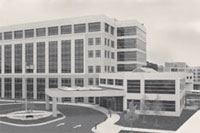
Although the new Millennium has hardly begun, advancements are evident throughout the entire health system, with new facilities, expanded programs, added service lines and prestigious awards. In addition to the many “Firsts” listed on pages 15-16, Riverside HealthCare is meeting the changing healthcare needs of those we serve with the following upgrades since 2000:
The new Riverside Pavilion makes comprehensive services more convenient and accessible than ever, adding more than 600 parking spaces and a new main entrance linked to Riverside Medical Center. The 115,000 sq. ft., 6-story facility is home to the Schneider Outpatient Center,Women’s Health Center, Riverside Cancer Institute and physicians’ offices. A temperature-controlled pedestrian walkway provides safe crossing over Wall Street in front of the Medical Center.
Renovated Family Birth Suites increased the number of labor-delivery-recovery suites to five, making plenty of room for the more than 1,400 babies born at Riverside each year. The Suites contain an Infant Care Center so newborns can be cleaned and weighed right there and kept cozy in a warming cabinet. A Special Care Nursery (Level II) is nearby to stabilize infants who are very sick or need surgery.
In June 2003, Riverside broke ground for the Betty Burch Bridgewater Center for Radiation Therapy. Dedicated to the memory of Mrs. Bridgewater, the Center was funded in part by a gift from the Bridgewater family and is part of the Riverside Cancer Institute, which delivers advanced cancer care and research to those impacted by cancer. The Riverside HealthCare Foundation also committed $3.5 million to the construction of the new Cancer Center and the volunteer Auxiliary committed $250,000 for a Cancer Education Center. The Center is a highly advanced facility that brings the latest cancer care technology to this area.
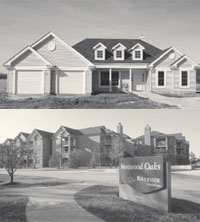
Expanded and renovated the Riverside Emergency Department, a Level II Trauma Center, not only added new registration and waiting areas but also added a new service to ensure timely care to those with non life-threatening injuries or sickness.
The Total Joint Resources Program, created with Orthopedic Associates of Kankakee, gives patients the advantage of clinical research being performed on leading-edge surgical techniques for knee and hip replacements combined with high-quality, coordinated care that ensures a quick and full recovery. Patients come to Riverside from throughout the State of Illinois, and several other states to access the excellent care provided by our program.
To strengthen the spiritual side of healing, Riverside created a Spiritual Healing Garden adjacent to the main waiting room on the first floor.
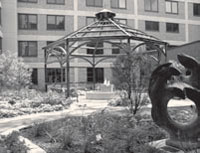
Riverside’s Senior Living Centers offer a full continuum of care that includes independent living (Westwood Oaks) and assisted living (Butterfield Court) as well as skilled and intermediate nursing care (Miller Center).Most recently, we opened Westwood Estates, featuring beautiful two-and three-bedroom ranch homes that offers independent living with all maintenance provided for a carefree lifestyle.
Riverside Medical Center is nationally recognized for its specialty areas in heart care, obstetrics, trauma, oncology, rehabilitation, geriatrics, occupational health, treatment of alcohol and chemical dependency, and psychiatric services. The Emergency Department is designated as a Level II Trauma Center and a Resource Hospital by the Illinois Department of Public Health.
While there’s no cure for diabetes, patients can learn to manage the disease to live a full, healthy life. Riverside’s Diabetes Self-Management Education Program received a Certificate of Recognition from the American Diabetes Association for meeting national standards in 2003. Certification has only been given to 23 programs in the entire State of Illinois.
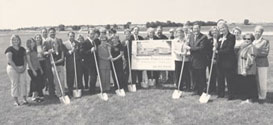
Riverside HealthCare continuously strives to meet the changing healthcare needs of the people who live in this Region, delivering quality services, the best patient satisfaction and the greatest convenience possible, coupled with the latest technology that enables our patients to receive excellent and comprehensive medical care. Riverside Spiritual Healing Garden completed in 2003.
Riverside HealthCare “Firsts”
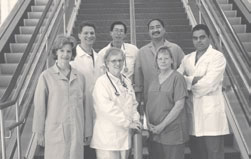
Front Row (left to right): Deb Rorabaugh, CVRN; LaRee Shule, APN/CNS and Linda Wilcox, CVCNOR, RNFA.
Back Row (left to right): Sam Dominico, CCP; Tim Luk, DO and Nester Rosales, CVRN.
As part of its mission to deliver quality, caring services that improve the health status of the communities we serve, Riverside is often the First in the Kankakee Region to use advanced care that benefits patients. Here are some of the most recent “Firsts” in procedures, equipment and services:
- Endovascular stent-graft (2003) for Abdominal Aortic Aneurysms (AAAs), a new minimally-invasive procedure that saves lives by repairing a bulge or weak spot in the major artery that feeds blood vessels supplying the brain, arms, legs and intestines.
- Cardiac drug-eluting stents (2003) slowly release a drug over a long period of time that prevents cleared blood vessels from closing up after angioplasty due to scar tissue. It’s a medical advancement that is revolutionizing angioplasty and cardiac care.
- Ambulatory Infusion Center (2002) enables those who need regular IV therapy, injections or related services to receive their treatments in a comfortable setting where they can watch TV, read or socialize.
- Aortic Dissection (2003). Just six weeks after actor John Ritter died from an aortic dissection (a leak in a main heart artery), Riverside Heart Center experts successfully repaired the dissection of Robert Gassman, sending him home a few days later to rest. Gassman benefited from the proven record of exceptional care our specialists deliver in a full spectrum of cardiac services that includes open-heart surgery.
- Toshiba 16-slice CT Scanner (2003), the cutting-edge of scanning technology, delivers not only speed but also a resolution so improved that CT scans are being used to find cancers previously too small or to examine small arteries or the organs of small children.
- Mammotone System®‚ Second LookTM System (2003), a computer-aided diagnostic system that greatly strengthens a radiologist’s ability to diagnose breast cancer in its early stages, aids in ultrasound guided breast biopsy and much more.
- Riverside Heart Center Women’s Heart Health Program (2004), focuses solely on women’s heart health.
- Bariatric Surgery (2003) is a multi-disciplinary program that provides several types of weight loss (or gastrointestinal) surgery for qualified candidates 80 to 100 pounds overweight whose obesity poses serious physical or health problems.
- Affiliation with the Rehabilitation Institute of Chicago, (2004) the number one rehabilitative hospital in the U.S., dramatically strengthens rehab services for area residents and greatly expands their access to care.
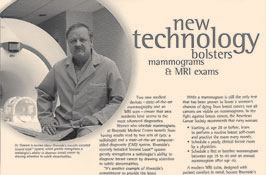
Facing Forward – What Lies Ahead?
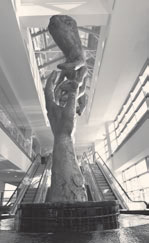
This 55-year history portrays more than a sentimental walk through time. It tells an American success story – an ambitious dream, years of hard work and neighbors caring about neighbors have made Riverside into a stronghold of the community.
In 2004 with total assets of over $330 million, 2,000 employees, over 200 physicians on staff, and facilities in three counties, Riverside Healthcare is prepared to further its mission of providing quality, caring services that improves the health status of the communities it serves.
How will the rest of the tapestry unfold? Our history creates a rich background – the present and future is in our hands.
Dedication
In consideration of the 40th Anniversary of Riverside Healthcare, this history was prepared with the assistance of Sharon Corzine Sills. She and Chief Executive Officer, Robert G. Miller, were the first employees of the hospital. This history is dedicated to their service and the service of those who have followed. To heal always, and to cure as often as possible, this legacy of the caring organization that was created 40-years ago, lives on today.